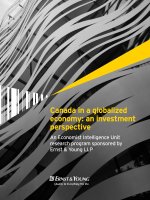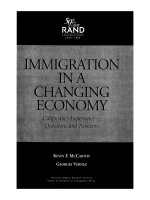monetary and fiscal policy in a closed economy
Bạn đang xem bản rút gọn của tài liệu. Xem và tải ngay bản đầy đủ của tài liệu tại đây (206.78 KB, 23 trang )
Chapter 25
Monetary and fiscal policy in a
closed economy
David Begg, Stanley Fischer and Rudiger Dornbusch, Economics,
6th Edition, McGraw-Hill, 2000
Power Point presentation by Peter Smith
25.1
Bringing together the real and financial sectors
Having seen equilibrium in the goods
and money markets separately,
it is now time to explore the links
between them
and to look at simultaneous
equilibrium in both.
25.2
Consumption revisited
Income is a key determinant of
consumption
but other factors shift the consumption
function
– household wealth
– availability of credit
– cost of credit
These create a link between the financial
and real sectors
– because interest rates can be seen to influence
consumption.
25.3
The permanent income hypothesis
A modern theory of consumption
developed by Milton Friedman
– argues that people like to smooth
planned consumption even if income
fluctuates
Consumption depends upon
permanent not transitory income.
25.4
Savings occur during
middle age
and dissaving in youth
and old age.
The life-cycle hypothesis
A theory of consumption developed by Ando and Modigliani.
Age
0
Death
Individuals try to smooth
their consumption, based
on expected lifetime
income.
Permanent
income
Thus wealth and interest rates may influence consumption.
Income varies over an
individual's lifetime.
Actual
income
25.5
Ricardian equivalence
Individuals will react to a shock such
as a tax change in different ways,
depending on whether changes are
seen to be temporary or permanent.
If the government cut taxes today,
but individuals realise this will have
to be balanced by higher taxes in the
future, then present consumption
may not adjust.
25.6
Investment demand
Investment spending includes:
– fixed capital
Transport equipment
Machinery & other equipment
Dwellings
Other buildings
Intangibles
– working capital
stocks (inventories)
work in progress
and is undertaken by private and public sectors
25.7
Analysis of fixed investment in the UK
by type of asset 1965-1998
0
20
40
60
80
100
120
140
160
1965
1975
1985
1995
£ billion
Trans Other mc/eq Dwellings Other build Intangible
Source: Economic Trends Annual Supplement, Monthly Digest of Statistics
25.8
The demand for fixed investment
Investment entails present sacrifice
for future gains
– firms incur costs in the short run
– but reap gains in the long run
Expected returns must outweigh the
opportunity cost if a project is to be
undertaken
so at relatively high interest rates,
less investment projects are viable.
25.9
The investment demand schedule
… shows how much investment firms wish to
undertake at each interest rate.
Investment demand
II
At relatively high interest
rates, less investment
projects are viable.
At r
0
, I
0
projects are viable.
r
0
I
0
but if the interest rate
rises to r
1
, desired
investment falls to I
1
.
r
1
I
1
25.10
Interest rates and aggregate demand
The position of the AD schedule is
now seen to depend upon interest
rates through the effects on
– consumption
– investment
25.11
Monetary policy
when aggregate demand depends upon the interest rate
Income
Aggregate demand
45
o
line
AD
0
Y
0
CC
0
Suppose the economy
starts with consumption
at CC
0
, investment at I
0
and equilibrium at Y
0
.
I
0
A fall in interest rates
shifts the consumption
function to CC
1
, and
leads to higher
investment at I
1
.
CC
1
I
1
Aggregate demand rises
to AD
1
, and the new
equilibrium is at Y
1
.
AD
1
Y
1
25.12
Fiscal policy and crowding out
Income
Aggregate demand
45
o
line
AD
0
Y
0
Suppose an increase in
government spending
shifts the AD curve to AD
1
.
AD
1
Initially, equilibrium
moves to Y
1
.
Y
1
But higher income raises
money demand, so
interest rates rise
and consumption and
investment fall, shifting AD
back to AD
2
and equilibrium
income to Y
2
.
AD
2
Y
2
25.13
Goods market equilibrium
The goods market is in equilibrium
when the aggregate demand and
actual income are equal
The IS schedule shows the different
combinations of income and interest
rates at which the goods market is in
equilibrium.
25.14
The IS schedule
Income
45
o
line
Income
r
AD
0
r
0
At a relatively high interest
rate r
0
, consumption and
investment are relatively
low – so AD is also low.
Y
0
Y
0
Equilibrium is at Y
0
.
Y
1
Y
1
Equilibrium is at Y
1
.
IS
The IS schedule shows all
the combinations of real
income and interest rate
at which the goods market
is in equilibrium.
AD
1
At a lower interest rate r
1
Consumption, investment
and AD are higher.
r
1
25.15
Money market equilibrium
The money market is in equilibrium
when the demand for real money
balances is equal to the supply.
The LM schedule shows the different
combinations of income and interest
rates at which the money market is in
equilibrium.
25.16
The LM schedule
r
r
Income
Real money
balances
L
0
LL
0
r
0
r
0
Y
0
At income Y
0
, money demand is at LL
0
and equilibrium
in the money market requires an interest rate of r
0
.
r
1
Y
1
r
1
LL
1
At Y
1
, money demand is at LL
1,
and equilibrium is at r
1
.
LM
The LM schedule traces out the combinations of real income
and interest rate in which the money market is in equilibrium.
25.17
Shifting IS and LM schedules
The position of the IS schedule
depends upon:
– anything (other than interest rates) that
shifts aggregate demand: e.g.
autonomous investment
autonomous consumption
government spending
The position of the LM schedule
depends upon
– money supply
– (the price level)
25.18
Equilibrium in goods and money markets
Income
r
IS
Bringing together the
IS schedule (showing
goods market equilibrium)
LM
and the LM schedule
(showing money market
equilibrium).
Y*
r*
We can identify the
unique combination of
real income and interest
rate (r*, Y*) which ensures
overall equilibrium.
25.19
Fiscal policy in the IS-LM model
Income
r
IS
0
LM
Y
0
r
0
Y
0
, r
0
represents the
initial equilibrium.
IS
1
A bond-financed
increase in government
spending shifts the IS
schedule to IS
1
.
r
1
Y
1
Equilibrium is now at
r
1
, Y
1
.
Some private spending
has been crowded out
by the increase in the
rate of interest.
25.20
Monetary policy in the IS-LM model
Income
r
IS
0
LM
0
Y
0
r
0
Y
0
, r
0
represents the
initial equilibrium.
LM
1
An increase in money
supply shifts the LM
schedule to the right.
Y
1
r
1
Equilibrium is now
at r
1
, Y
1
.
25.21
The composition of aggregate demand
Income
r
Demand management is the use of monetary and fiscal policy
to stabilize the level of income around a high average level.
Y*
Income level Y* can
be attained by:
LM
0
IS
0
r
2
‘Tight’ fiscal policy (IS
0
)
with ‘easy’ monetary
policy (LM
0
)
IS
1
LM
1
r
1
OR with ‘easy’ fiscal
policy (IS
1
) with ‘tight’
monetary policy (LM
1
).
This affects the private:
public balance of spending
in the economy.
25.22
But
The IS-LM model seems to offer
government a range of options for
influencing equilibrium income.
But…
– there are other issues to be considered
the price level and inflation
the supply-side of the economy
the exchange rate









